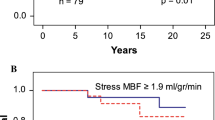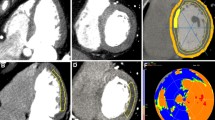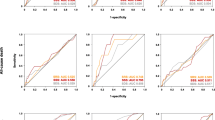Abstract
Background. Rest tomographic myocardial perfusion imaging (MPI) has significant utility for clinical decision making in emergency department chest pain patients. The role of functional data, commonly acquired with perfusion, has not been systematically evaluated.
Methods and Results. Low- to moderate-risk patients undergoing rest MPI for risk stratification were included. The patients’ MPI findings were classified as normal (normal perfusion or function), abnormal (perfusion defect with abnormal regional function), or discordant (perfusion defect with normal regional function). Ejection fraction was determined from the gated MPI studies. Events based on perfusion classifications and ejection fraction were evaluated. A total of 2,826 consecutive patients (abnormal MPI results in 40%, normal in 32%, and discordant in 27%) were studied. Outcomes were similar for those with normal MPI results versus those with discordant MPI results (myocardial infarction [MI] based on troponin I [TnI], 3.5% vs 4.0%; MI based on creatine kinase-MB, 1.5% vs 1.7%; revascularization, 5.2% vs 5.5%; and MI/revascularization based on TnI, 7.9% vs 8.1%) (P=not significant for all). Both groups had significantly fewer events (P<.001 for all) when compared with patients with abnormal MPI studies (MI based on TnI, 15%; MI based on creatine kinase-MB, 10%; revascularization, 17%; MI based on TnI or revascularization, 24%). The mortality rate was not different among the 3 groups. Multivariate analysis showed that mild/moderate and severe systolic dysfunction were independent predictors of 30-day and 1-year mortality rates (P=.001).
Conclusions. The concurrent evaluation of perfusion and function (regional and global) with MPI provides significant risk/outcome predictive power.
Similar content being viewed by others
References
Tatum JL, Jesse RL, Kontos MC, Nicholson CS, Schmidt KL, Roberts CS, et al. Comprehensive strategy for the evaluation and triage of the chest pain patient. Ann Emerg Med 1997;29:116–23.
Heller GV, Stowers SA, Hendel RC, Herman SD, Daher E, Ahlberg AW, et al. Clinical value of acute rest technetium-99m tetrofosmin tomographic myocardial perfusion imaging in patients with acute chest pain and nondiagnostic electrocardiograms. J Am Coll Cardiol 1998;31:1011–7.
Udelson JE, Beshansky JR, Ballin DS, Feldman JA, Griffith JL, Handler J, et al. Myocardial perfusion imaging for evaluation and triage of patients with suspected acute cardiac ischemia: A randomized controlled trial. JAMA 2002;288:2693–700.
Klocke FJ, Baird MG, Lorell BH, Bateman TM, Messer JV, Berman DS, et al. ACC/AHA/ASNC guidelines for the clinical use of cardiac radionuclide imaging—executive summary: A report of the American College of Cardiology/American Heart Association Task Force on Practice Guidelines (ACC/AHA/ASNC Committee to Revise the 1995 Guidelines for the Clinical Use of Cardiac Radionuclide Imaging). J Am Coll Cardiol 2003;42:1318–33.
Hilton TC, Thompson RC, Williams HJ, Saylors R, Fulmer H, Stowers SA. Technetium-99m sestamibi myocardial perfusion imaging in the emergency room evaluation of chest pain. J Am Coll Cardiol 1994;23:1016–22.
Boucher CA, Wackers FJ, Zaret BL, Mena IG. Technetium-99m sestamibi myocardial imaging at rest for assessment of myocardial infarction and first-pass ejection fraction. Multicenter Cardiolite Study Group. Am J Cardiol 1992;69:22–7.
DePuey EG, Rozanski A. Using gated technetium-99m-sestamibi SPECT to characterize fixed myocardial defects as infarct or artifact. J Nucl Med 1995;36:952–5.
Taillefer R, DePuey EG, Udelson JE, Beller GA, Latour Y, Reeves F. Comparative diagnostic accuracy of Tl-201 and Tc-99m sestamibi SPECT imaging (perfusion and ECG-gated SPECT) in detecting coronary artery disease in women. J Am Coll Cardiol 1997;29:69–77.
Risk stratification and survival after myocardial infarction. N Engl J Med 1983;309:331–6.
Zaret BL, Wackers FJ, Terrin ML, Forman SA, Williams DO, Knatterud GL, et al. Value of radionuclide rest and exercise left ventricular ejection fraction in assessing survival of patients after thrombolytic therapy for acute myocardial infarction: Results of Thrombolysis in Myocardial Infarction (TIMI) phase II study. The TIMI Study Group. J Am Coll Cardiol 1995;26:73–9.
Nicolosi GL, Latini R, Marino P, Maggioni AP, Barlera S, Franzosi MG, et al. The prognostic value of predischarge quantitative two-dimensional echocardiographic measurements and the effects of early lisinopril treatment on left ventricular structure and function after acute myocardial infarction in the GISSI-3 Trial. Gruppo Italiano per lo Studio della Sopravvivenza nell’Infarto Miocardico. Eur Heart J 1996;17:1646–56.
Germano G, Kiat H, Kavanagh PB, Moriel M, Mazzanti M, Su HT, et al. Automatic quantification of ejection fraction from gated myocardial perfusion SPECT. J Nucl Med 1995;36:2138–47.
Kontos MC, Shah R, Fritz LM, Anderson FP, Tatum JL, Ornato JP, et al. Implication of different cardiac troponin I levels for clinical outcomes and prognosis of acute chest pain patients. J Am Coll Cardiol 2004;43:958–65.
Alpert JS, Thygesen K, Antman E, Bassand JP. Myocardial infarction redefined—a consensus document of the Joint European Society of Cardiology/American College of Cardiology Committee for the redefinition of myocardial infarction. J Am Coll Cardiol 2000;36:959–69.
Sharir T, Kang X, Germano G, Bax JJ, Shaw LJ, Gransar H, et al. Prognostic value of poststress left ventricular volume and ejection fraction by gated myocardial perfusion SPECT in women and men: Gender-related differences in normal limits and outcomes. J Nucl Cardiol 2006;13:495–506.
Ababneh AA, Sciacca RR, Kim B, Bergmann SR. Normal limits for left ventricular ejection fraction and volumes estimated with gated myocardial perfusion imaging in patients with normal exercise test results: Influence of tracer, gender, and acquisition camera. J Nucl Cardiol 2000;7:661–8.
Solomon SD, Anavekar N, Skali H, McMurray JJ, Swedberg K, Yusuf S, et al. Influence of ejection fraction on cardiovascular outcomes in a broad spectrum of heart failure patients. Circulation 2005;112:3738–44.
Hasdai D, Topol EJ, Kilaru R, Battler A, Harrington RA, Vahanian A, et al. Frequency, patient characteristics, and outcomes of mild-to-moderate heart failure complicating ST-segment elevation acute myocardial infarction: Lessons from 4 international fibrinolytic therapy trials. Am Heart J 2003;145:73–9.
Burns RJ, Gibbons RJ, Yi Q, Roberts RS, Miller TD, Schaer GL, et al. The relationships of left ventricular ejection fraction, end-systolic volume index and infarct size to six-month mortality after hospital discharge following myocardial infarction treated by thrombolysis. J Am Coll Cardiol 2002;39:30–6.
Singh M, Reeder GS, Jacobsen SJ, Weston S, Killian J, Roger VL. Scores for post-myocardial infarction risk stratification in the community. Circulation 2002;106:2309–14.
Krumholz HM, Chen J, Chen YT, Wang Y, Radford MJ. Predicting one-year mortality among elderly survivors of hospitalization for an acute myocardial infarction: Results from the Cooperative Cardiovascular Project. J Am Coll Cardiol 2001;38:453–9.
Effect of enalapril on mortality and the development of heart failure in asymptomatic patients with reduced left ventricular ejection fractions. The SOLVD Investigators [published erratum appears in N Engl J Med 1992;327:1768]. N Engl J Med 1992; 327:685–91.
Sharir T, Germano G, Kang X, Lewin HC, Miranda R, Cohen I, et al. Prediction of myocardial infarction versus cardiac death by gated myocardial perfusion SPECT: Risk stratification by the amount of stress-induced ischemia and the poststress ejection fraction. J Nucl Med 2001;42:831–7.
Bourque JM, Velazquez EJ, Tuttle RH, Shaw LK, O’Connor CM, Borges-Neto S. Mortality risk associated with ejection fraction differs across resting nuclear perfusion findings. J Nucl Cardiol 2007;14:165–73.
Kaul S, Senior R, Firschke C, Wang XQ, Lindner J, Villanueva FS, et al. Incremental value of cardiac imaging in patients presenting to the emergency department with chest pain and without ST-segment elevation: A multicenter study. Am Heart J 2004;148:129–36.
Emre A, Ersek B, Gursurer M, Aksoy M, Siber T, Engin O, et al. Angiographic and scintigraphic (perfusion and electrocardiogram-gated SPECT) correlates of clinical presentation in unstable angina. Clin Cardiol 2000;23:495–500.
Topol EJ, Weiss JL, Brinker JA, Brin KP, Gottlieb SO, Becker LC, et al. Regional wall motion improvement after coronary thrombolysis with recombinant tissue plasminogen activator: Importance of coronary angioplasty. J Am Coll Cardiol 1985;6:426–33.
Jeroudi MO, Cheirif J, Habib G, Bolli R. Prolonged wall motion abnormalities after chest pain at rest in patients with unstable angina: A possible manifestation of myocardial stunning. Am Heart J 1994;127:1241–50.
Krumholz HM, Douglas PS, Goldman L, Waksmonski C. Clinical utility of transthoracic two-dimensional and Doppler echocardiography. J Am Coll Cardiol 1994;24:125–31.
de Zwaan C, Cheriex EC, Braat SH, Stappers JL, Wellens HJ. Improvement of systolic and diastolic left ventricular wall motion by serial echocardiograms in selected patients treated for unstable angina. Am Heart J 1991;121:789–97.
Koch KC, vom Dahl J, Kleinhans E, Klues HG, Radke PW, Ninnemann S, et al. Influence of a platelet GPIIb/IIIa receptor antagonist on myocardial hypoperfusion during rotational atherectomy as assessed by myocardial Tc-99m sestamibi scintigraphy. J Am Coll Cardiol 1999;33:998–1004.
Gibbons RJ, Christian TF, Hopfenspirger M, Hodge DO, Bailey KR. Myocardium at risk and infarct size after thrombolytic therapy for acute myocardial infarction: Implications for the design of randomized trials of acute intervention. J Am Coll Cardiol 1994; 24:616–23.
Kontos MC, Kurdziel KA, Ornato JP, Schmidt KA, Jesse RL, Tatum JL. A nonischemic electrocardiogram does not always predict a small myocardial infarction: Results with acute myocardial perfusion imaging. Am Heart J 2001;141: 360–6.
Author information
Authors and Affiliations
Corresponding author
Rights and permissions
About this article
Cite this article
Kontos, M.C., Haney, A., Ornato, J.P. et al. Value of simultaneous functional assessment in association with acute rest perfusion imaging for predicting short- and long-term outcomes in emergency department patients with chest pain. J Nucl Cardiol 15, 774–782 (2008). https://doi.org/10.1007/BF03007358
Received:
Revised:
Issue Date:
DOI: https://doi.org/10.1007/BF03007358




